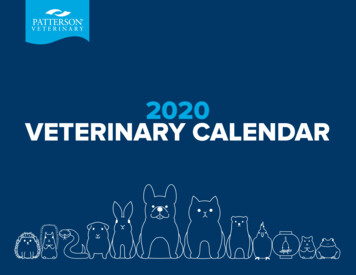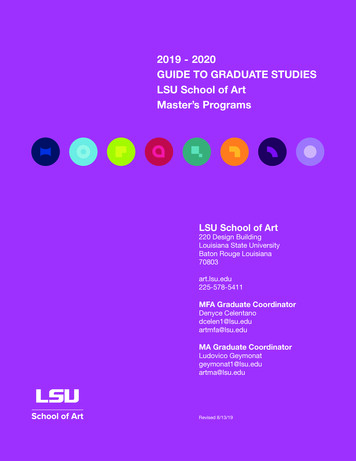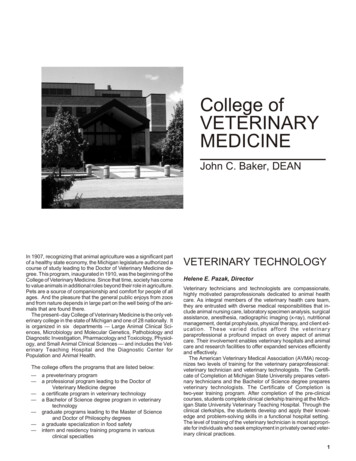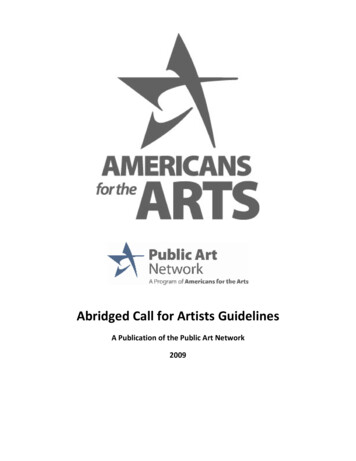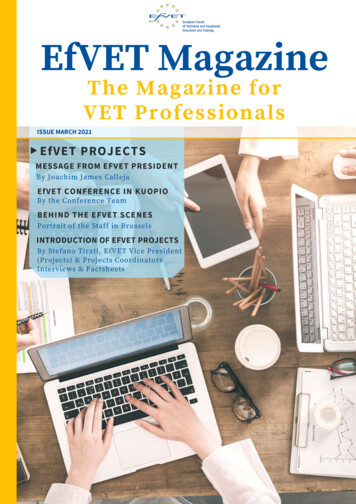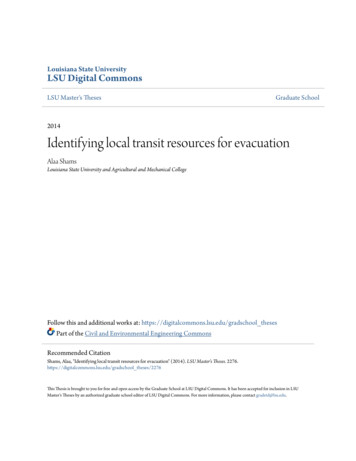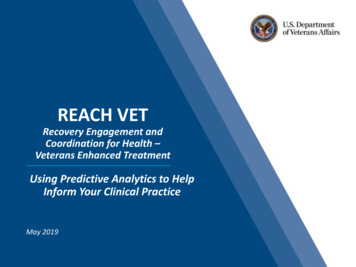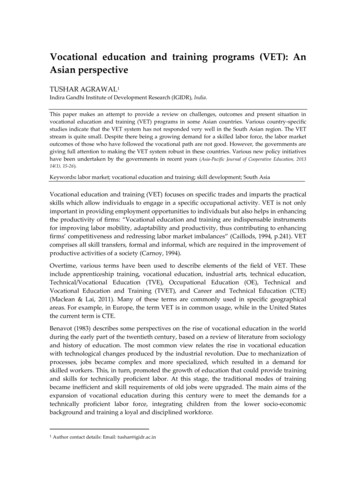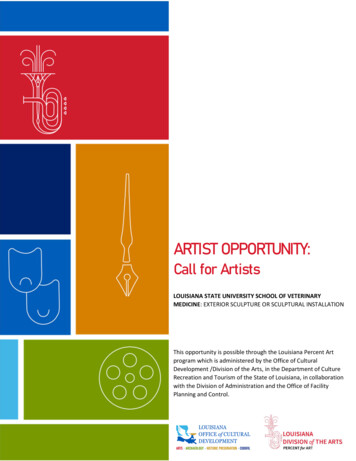
Transcription
ARTIST OPPORTUNITY:Call for ArtistsLOUISIANA STATE UNIVERSITY SCHOOL OF VETERINARYMEDICINE: EXTERIOR SCULPTURE OR SCULPTURAL INSTALLATIONThis opportunity is possible through the Louisiana Percent Artprogram which is administered by the Office of CulturalDevelopment /Division of the Arts, in the Department of CultureRecreation and Tourism of the State of Louisiana, in collaborationwith the Division of Administration and the Office of FacilityPlanning and Control.
ARTIST OPPORTUNITY: CALL FOR ARTISTSOverviewThe Louisiana Percent for Art program is seeking qualified artists or artist teams to submit qualifications to design andimplement an exterior, site-specific sculpture of original design for the Louisiana State University School of VeterinaryMedicine. Full proposals are not required at this time, therefore, please only submit those materials described undersubmission requirements.Submission RequirementsApplication materials must be received by November 28th via the Call for Entry (CaFÉ) system available online atwww.callforentry.org. Deadlines in CaFÉ are at 11:59 PM Mountain Time Zone [Denver, Colorado, USA] on the day ofthe deadline.The CAFÉ system will remain open until 11:59 PM MDT on November 28th. Staff will only be available for technical orwebsite assistance Monday – Friday from 8:30 AM – 5:00 PM MDT (Holidays may affect this time). Applicants areencouraged to apply early to reduce risk of technical difficulties. Incomplete or late submissions will not be accepted forany reason.A complete application must include: Artist résumé demonstrating a minimum of five (5) years of professional visual art experience (NOT STUDENTWORK). If submitting as a team, a current résumé should be submitted for each team member (Compiled intoone document). A biography will not be accepted in place of a résumé.Statement of interest describing:1. Why you are interested in this project2. Previous experience with public art3. Your connection (if any) or interest in Louisiana State University4. How you believe the art will enhance the chosen spaceReferences that include the names and current contact information for three (3) individuals with whom youhave worked, collaborated, or who have commissioned your work in the past.References will be contacted for artists invited to develop a proposal for the commission.Images (6) of your original completed commissions, not proposals, which demonstrate your qualifications forthe project. 3-D models, sketches, or drawings will not be accepted. You must include the title, medium,dimensions, project budget (price), year completed, location, and a description. The value must be indicated inUS dollars. Each image must contain only one view of the work.Multiple views per image or unexecuted conceptual projects will not be considered, and may disqualify yoursubmission.Image specifications: JPG, PNG - Maximum size per image 5MB, total 30MB.*Slides, emailed prints, or any physical submissions will NOT be accepted.EligibilityThis call for artists is open to professional artists 18 and over, regardless of race, color, religion, national origin, genderidentification, military status, sexual orientation, marital status, or physical ability.
Artist teams may apply and must designate one artist as the lead contact. Examples of work submitted must beoriginal, recently completed artwork (within the last 10 years).The application, including all examples of work and supporting documents are considered the artist’s official“submission.” If any information submitted by the artist or artist’s representative, including all supporting documents, isfound fraudulent the submission will be disqualified.BudgetThe proposal selected by the committee will include an all-inclusive budget of 90,000 to cover all costs associated withthe project, and commensurate with the intended scale, including but not limited to: research, professionalconsultations, formal reports from licensed structural and electrical engineers where appropriate, a long-term care andmaintenance report from a licensed professional conservator, materials, fabrication, transportation, travel, insurance,installation, and photography and documentation of the artwork.BackgroundOverviewThe Louisiana State University School of VeterinaryMedicine (LSU SVM), is located in the vibrant city of BatonRouge. In addition to their dedication to excellence intraining practice-ready veterinarians, LSU SVM emphasizesbasic, clinical, and translational research and providesworld-class clinical services to their patients.A Veterinary Professional degree prepares their studentsfor various exciting careers that focus on animal health andwelfare. Since accepting their first class of students in 1973,they have trained more than 2,700 veterinarians who have gone on to excellence in private primary and specialtyveterinary practices, biotechnology and pharmacology industries, public health, and academic research and training.They also have a rigorous and active graduate program that trains towards a Ph.D. degree. Ph.D. training is open to bothDVMs and those with undergraduate degrees interested in biomedical research. Although there are excellentopportunities in many research areas within the school, their graduate programs excel in research on equine health,vector-borne infectious diseases, respiratory diseases, and molecular medicine and imaging. As evidence of thisexcellence, they rank in the top third of veterinary schools in the United States in funding from the National Institutes ofHealth. Their faculty also obtain multiple grants from foundations, including the Flight Attendant Medical ResearchInstitute (FAMRI) which funds research on mechanisms underlying lower respiratory diseases, the Morris AnimalFoundation (MAF) which funds projects concerning companion animal health and welfare, and industrial partnerships inwhich they help evaluate new treatments.LSU SVM extensively collaborates in their research, education, and service missions with other institutes in Louisiana,including the Tulane National Primate Center, Pennington Biomedical Research Center, the National Hansen’s DiseaseCenter, and the LSU Health Services Centers. They work with these institutes to relentlessly pursue new understandingto foster discoveries leading to the treatment and prevention of animal and human diseases.LSU SVM also trains veterinarians working towards board certification in Veterinary Specialties, with interns andresidents pursuing advanced training in various specialties. Many of their trainees become leaders in academicveterinary medicine at institutions around the world.
It is an exciting time for new veterinarians, as they are universally recognized for their deep and broad understanding ofhealth and disease in diverse animal species. This makes the veterinarian uniquely qualified to contribute in everexpanding ways to foster both human and animal health, and to contribute to discovery as part of the biomedicalworkforce. Whether it is work in private practice healing one animal or one herd at a time, work at the Centers forDisease Control to manage emerging threats from infectious agents, produce a vaccine that can protect millions ofanimals worldwide, assess environmental pollutants and their effects on animals and ecosystems, work internationallyto sustain local agriculture, or ensuring food safety here at home. All these and many more opportunities are availableto the recent graduate.HistoryThe school admitted its first students to the professional curriculum during the 1973-1974 academic year. The originalentering class consisted of 36 students, all residents of Louisiana, receiving their DVM degrees in 1977. The school hasgranted more than 3,200 DVM degrees since 1977, as well as 450 MS and PhD degrees.Class size increased significantly in subsequent years. The school participates in the Southern Regional Education Board’sprogram for education in veterinary medicine. Training contracts provide a limited number of entering spaces forqualified candidates from Arkansas. In addition, a limited number of highly qualified, nonresident applicants areadmitted under the school’s special admission policy.Facts The Veterinary Medicine Building, located on the west side of the campus near the Mississippi, was dedicated inOctober 1978.It houses three academic departments plus the Veterinary Medicine Library, the Veterinary Teaching Hospital &Clinics, and the Louisiana Animal Disease Diagnostic Laboratory.The facilities at the Veterinary Teaching Hospital & Clinics are used as laboratories where students areintroduced to clinical cases and animal disease problems, as well as to methods and techniques used in theirsolution.The clinical case load at the hospital in-field services, and herd health programs offer ample opportunities forthe complete veterinarian’s education.ResearchTotal extramural funding for the LSU School of Veterinary Medicine’s research programs tops 40 million each year. Themajority of these dollars come from the federal government followed by state, foundation, and industry funds.Department of Pathobiological Sciences in the School of Veterinary Medicine is currently ranked #1 in researchproductivity at LSU. The research emphasis is on infectious diseases, with strong programs in viral and bacterialpathogenesis, immunity and resistance to infectious agents, vector-borne diseases and use of Geographic InformationSystems to study disease distribution and risk factors.Outreach The Veterinary Teaching Hospital sees more than 28,000 cases each year.The Wildlife Hospital treats approximately 1,000 wildlife cases each year. The goal is to treat and release theseanimals back into the wild.The Annual Open House, which takes place in January/February of each year, sees more than 5,000 visitors.
Public Art Location & GoalsThe School of Veterinary Medicine is a major contributor to the impact LSU has on Baton Rouge, the state, and thecountry. It is on the edge of campus near the Mississippi River Levee, and the current construction of the newStephenson Pet Clinic will welcome the community as the primary public entrance to the facility. Many four-leggedfriends in Baton Rouge are cared for by the amazing team of faculty, staff and students. The Vet School’s primaryobjective is to train the next generation of doctors in the health of animals – from pets to horses, exotics to foodanimals. Research on disease is also a prominent part of the curriculum.The goal of this public art project is to welcome “clients” (their owners) to the new “front door”. The piece should speakto the healing work done within the facility. The sculpture will sit on the front lawn with 360 degree viewing. TheUniversity is interested in physically engaging people with the sculpture.A durable, long-lasting, extremely low maintenance sculpture is required. The piece should be seen and recognized fromthe road, interacted with close up, and stand out against the backdrop of the building. The university would beinterested in the use of color in the piece. It should be lighted at night, however the piece should not depend on light asthe primary design idea.The cost of foundation design and installation will be included in the design. The landscape and hardscape providingaccess to and around the piece will be required to be included in the design and construction cost. Lighting will berequired as part of design and construction cost. LSU will provide conduit and wiring for one dedicated circuit from thebuilding to the site.Scope of WorkThe development and design for the artwork should: Consider the elements of the site as a source of design ideas.Consider the facility and the area(s) surrounding the artwork and their intended uses as described in this call.Reflect LSU SVM’s history, diversity and cultural profileBe durable, sturdy, stable, suitable for the climate conditions, resistant to UV damage, and safe for publicinteraction.Selection Process & Evaluation CriteriaAn Art Selection Committee (the Committee) may include (but is not limited to) representatives from the LouisianaOffice of Facility Planning & Control, the architectural firm that designed the facility, representatives from LSU,professional artist(s), and the State Arts Council will review all eligible artist submissions.Submissions are evaluated by the following criteria: Artistic excellence and originality as evidenced by the representations of past work images and other supportingmaterialsAppropriateness of artist’s medium, style, and previous experience as they relate to the project goals and settingExperience with projects of a similar scale and scopeAbility to create site-specific or site-reactive worksAvailability to participate in the design and implementation of the project as requiredSpecial consideration will be given to Louisiana artists as defined by La. R.S.25:9000.1(E)
The committee may also take into consideration when selecting artists whether or not an artist is alreadyrepresented in the state’s collectionNotifications and ProposalsNotifications will be issued by the end of December 2021. A full timeline will be provided to those finalists who havebeen shortlisted.This is a call for the submission of proposals. If your proposal is selected, you will be contacted by the Percent for Artprogram staff. A selection will be made within two weeks of the proposal meeting.Finalists will be required to attend two (2) meetings: a site visit to meet with the Committee and to view the space, andthe presentation of the artist’s proposal before the Committee.The proposal must include the concept, materials, size, weight, installation requirements, details of maintenance, andbudget. The proposal must also include a maquette (if applicable) or digital renderings, which displays the physicalvolume of the space and allows for multiple perspectives of the artwork within the space.All proposal documents, including the maquette and renderings, will become property of the State of Louisiana and willbe used for educational and/or promotional purposes of the program. Each finalist’s proposal and/or maquette may beexhibited for Committee and community consideration.An honorarium/proposal fee of 1,500 will be paid to artists to offset expenses associated with the development ofproposals and travel (if applicable).NOTE: "The Percent for Art Program and the Artist Selection Committee reserves the right to change, modify, or revisethe Call to Artists, in part or whole, at any time before the submittal deadline without prior notice. Any change,modification or revision can be found here. The Percent for Art Program and the Artist Selection Committee also reservesthe right to reject any or all applications or proposals, to reject any finalist, or to terminate the selection process for anyproject without prior notice."The Louisiana Percent for Art Program was established by law in the 1999 legislative session. The law specifies that onprojects using more than 2,000,000.00 in state funds, one percent (1%) of the expenditure for construction orrenovation of a state building shall be for works of art by artists and craftsmen for the building or its grounds.Please direct questions about the Percent for Art Program or this project to:Scott Finch, DirectorPhone: 225-342-8176 Email: sfinch@crt.la.govApril Baham, Project ManagerPhone: 225-342-6083 Email: abaham@crt.la.govwww.louisianaarts.org
Medicine (LSU SVM), is located in the vibrant city of Baton Rouge. In addition to their dedication to excellence in training practice-ready veterinarians, LSU SVM emphasizes basic, clinical, and translational research and provides world-class clinical services to their patients. A Veterinary Professional degree prepares their students
